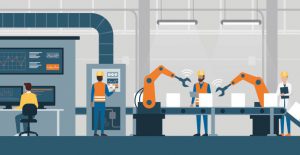IBM first introduced the AS/400 systems in 1988, with its own OS/400 operating system and an embedded database. Today, it is more familiarly known as IBM System I or the i-Series. It is used not only by midsize companies but many Fortune 500 companies as well. Over the years, AS/400 has been well known for its robustness, scalability, reliability, security and low cost of ownership. Today, however the need to integrate with other technologies, organizations are looking to modernize the AS/400 applications and move toward newer and more open platforms.
AS/400 systems are capable of storing large volumes of valuable information and core business logic. As data becomes the key driver for business intelligence, the need arises to tap into these 5250-based green screens and extract information while still balancing the cost, risk and develop a better and modern user-friendly system. Moreover, survey shows, users are also dissatisfied with outdated interface, lack of major functionality updates, not timely or up-to-date information.
Apart from that, programmers who are knowledgeable in various legacy applications – RPG, COBOL are also difficult to find as more and more reach retirement age. To attract talented, mid-career professionals, organizations need to invest or upgrade their technology and systems that will not be hard to use and restrict their efficiency. While the cost of hardware may not be the issue, the total cost of ownership increases due to higher cost of skilled resources and support fees. A cost assessment by Infosys showed that there is a 35% reduction in TCO between AS/400 upgrade and Re-hosting cost.
Modernization approaches
Organizations face different modernization options — rehost, replatform or rebuild. All have different purposes, effects, values, costs, risks and impacts. But which one is right?
“Application modernization is not one ‘thing,’” says Stefan van der Zijden, research director at Gartner. “If you’re faced with a legacy challenge, the best approach depends on the problem you’re trying to solve. Replacement isn’t the only option.”
Gartner has identified 7 options for modernizing the Legacy applications:
- Encapsulate. To leverage and extend an application’s features and value, encapsulate data and functions in the application and make them available as services via an application programming interface (API).
- Re-host. Redeploy an application component to another physical, virtual or cloud infrastructure without recompiling, altering the application code, or modifying features and functions. This does not require any change to existing interfaces and it can run on x86-64 cloud-based interface.
- Re-platform. Migrate an application component to a new runtime platform. Make minimal changes to code to adapt to the new platform.
- Refactor. Restructure and optimize existing code without changing its external behavior to remove technical debt and to improve the component’s features and structure.
- Re-architect. Materially alter the application code so you can shift it to a new application architecture and fully exploit new and better capabilities of the application platform.
- Rebuild/Re-engineer. Rebuild or rewrite the application component from scratch while preserving its scope and specifications. them available as services via an application programming interface (API).
- Replace. Eliminate the former application component altogether and replace it, taking new requirements and needs into account.
Re-engineered AS/400 Application
Re-engineering is migrating batch jobs to the cloud – make batch near real-time, event-driven and use open-source tools. Files that are created in the system are sent to cloud storage for quick access and analytics. Hadoop, Spark etc are leveraged to perform analytics on the data. The output can be used for dashboards or in the form of reports. From AS/400 real-time data streams such as MQ, web services etc are sent to cloud data streams, processed and analyzed and then used for dashboards and other visualization. Applications can also run code without the server by only paying for computing time. This can be done with a cloud-based API Gateway and server-less applications like AWS/Azure. Applications built using server-less architecture follows event-driven approach. The in-memory caching layer creates faster response time this helping solve the challenges within Micro Services. Cloud container services (SAP and other ERP) enable workflows and other application services that can be managed at scale using cloud native services or other open source applications. Data Persistence Layer manages relational databases, NoSQL database and data warehouses to enable customers to effectively store and analyze data.
Benefits of AS/400 Modernization
Regardless of whatever process is chosen, there are multiple benefits of AS/400 modernization.
- Improved and Enriched customer experience including other users.
- Re-design using popular web frameworks such as Angular, React, HTML 5, etc.
- Low cost up-gradation without modifying core business rules.
- Ease of access and Integration with mobile devices.
- Streamlined Application Workflow.
- More flexible applications.
- New business requirements are easier to implement.
- Better resource availability.
How MTS US can help ?
With our dedicated Center of Excellence for IBM i for over a decade and our common framework solution approach for all types of enterprises have helped Re-engineer, Re-Architect several applications on cloud for scalability, agility and higher performance.
- Dedicated Center of Excellence for IBM i (AS/400) since 2008
- Web Workflow Architecture Diagramming (WWAD) using specialized tools
- Common Framework and Workflow for mobile devices
- Reusability of web services with web, mobile or tablets
- World class secure implementation
- Validation and Optimization with business Subject Matter Experts
- Restructure existing Business Modules as REST API’s and expose existing RPG ILE, COBOL, Service Programs using IBM Integrated Web Services (IWS)
- Automated Testing for customization
We at MSID would love to hear from you and together we can start exploring the modernization.
References
https://www.gartner.com/smarterwithgartner/7-options-to-modernize-legacy-systems/
https://www.infosys.com/services/modernization/as400-applications.html
About the Author:

Team
Motherson Technology Services USA Limited








